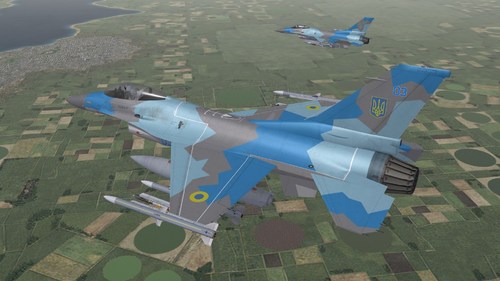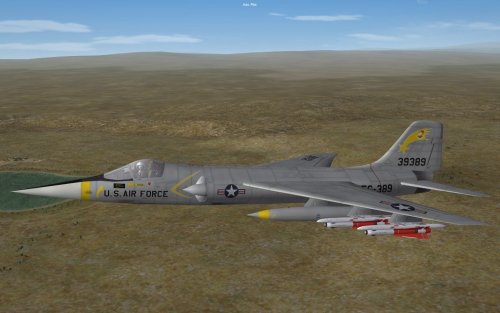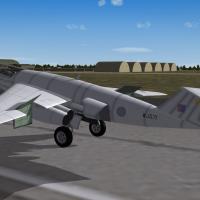Fictional Mirage F1AZ for Israel called F1AZI
Skin by Valastur based on the original Ludo Mirage F1AZ and templates so kudos to Ludo and team for such a wonderful mod. Edition of the plane inis also by Valastur.
Valastur 2022

This is an standalone F-16 as If Ukraine recieved them starting in 2022. Is based on the Viper Team F-16C Blk25/30 and is basically a repaint with some DATA inis and added the Lightning pod, I added the original readme down there, please read it and pay respects to them. Skin and DATA edition by AngelP. Kudos to him!!
Enjoy!
F-16C Blk25/30 By the Viper Team.
Pit by ravenclaw. (A master piece and you haven't seen nuttin' yet.)
Models by bpao, modified highly by Jat and ravenclaw. (You guys are one hell of a team)
Skins templates by Migbuster (Went back and made even higher res skins...because he could)
MFD panel glass by Stary (Did you know he does terrains and clouds too?)
Units skins by Dave and Jat (I think Jat did like 4 and I did the other 70 or so) lol
Weapons by ravenclaw and GrinchWSLG (Masters of disaster)
Technical adviser, Sony Tuckson (If we got it wrong he cracked the whip!)
Avionics by Jat and Crusader (You cant get anything past Crusader, the best MK1 eyeball in SF)
To install:
Drop into your C:\Users\xxxxxx\Saved Games\ThirdWire\StrikeFighters XXXXX
This project started with a little mod here and there to make the Vipers more modern. FastCargo started the PM thread on 28 Jul 2011 and here we are 10 months later we have this.
This mod is dedicated to Oli (bpao) he started us on this journey and I hope, I really hope, we lived up to his expectations.

The F104M by CAF team, 3d work by Cocas, skins by Nyghtfall, other ini work by Coupi, testing by Stratos, Coupi, Wrench, Nyghtfall.
Some small whatif background:
The Lockheed F104M was a 1960s company-funded proposal for an improved air superiority Lockheed F-104 Starfighter. It was intended for both the USAF and the export market and was in direct competition with the Northrop F-5E Tiger II, Dassault Mirage F1 and the McDonnell Douglas F-4 Phantom II. Lockheed hoped to capitalize on its F-104 production experience through commonality of parts and systems, and minimize expenses by reusing tooling, jigs and existing factory facilities.
Borrowing heavily from the F-104 design the new type featured a new high-mounted, increased span wing and low-mounted, enlarged tailplanes. Both features were incorporated to improve flight handling characteristics and short-field performance.
The F104M was heavily focused for the USAF, trying to sell it as a improved dogfighter variant of the F104 interceptor. Seeing how the F104 small payload and relatively low agility can be a problem If dogfight capability ever arise, the USAF decided to try several prototypes. They liked the plane so much that several squadrons were equipped with the plane that formed part of the USAF until mid 70's.
Included: One plane with several skins and variations.

The F104L by CAF team, 3d work by Cocas, skins by Nyghtfall, other ini work by Coupi, testing by Stratos, Coupi, Wrench, Nyghtfall.
Some small whatif background:
The Lockheed F104L was a 1950s company-funded proposal for an embarked Lockheed F-104 Starfighter. It was intended for both the USN and Lockheed hoped to capitalize on its F-104 production experience through commonality of parts and systems, and minimize expenses by reusing tooling, jigs and existing factory facilities.
Borrowing heavily from the F-104 design the new type featured a strenghtened landing gear, corrosion portection, increased span wing and of course catapult and arreting gear additions.
The F104L was a specific product for the USN and the USMC, trying to sell it as a fast interceptor with better payload and range than the USAF F104. Both USN and USMC bought a good amount of planes and it saw service in both forces during the Vietnam war as a fighter for the USN and as a STRIKE and CAS airplane for the MARINES. Both services praised the speed and capability of the new planes, but also criticized the slow speed handling, that posed serious problem for a carrier aircraft.
After getting several kills and a good service record in Vietnam, planes were retired froma ctive duty in 1972, altought USMC used the plane for fast Strike for more several years.
Included: Skins for USN VF162 and for USMC VMFA311
The template pack for the MiG-19SK, all the templates works by Nyghtfall

The MiG-19SK by CAF team, 3d work by Cocas, skins by Nyghtfall, other work by Coupi, testing by Stratos, Coupi, Wrench, Nyghtfall.
Some Background:
After the success of the Soviet Union’s first carrier ship, the Moskva Class (Projekt 1123, also called „Кондор“/„Kondor“) cruisers in the mid 1960s, the country became more ambitious. This resulted in Project 1153 Orel (Russian: Орёл, Eagle), a planned 1970s-era Soviet program to give the Soviet Navy a true blue water aviation capability. Project Orel would have resulted in a program very similar to the aircraft carriers available to the U.S. Navy. The ship would have been about 75-80,000 tons displacement, with a nuclear power plant and carried about 70 aircraft launched via steam catapults – the first Soviet aircraft carrier that would be able to deploy fixed-wing aircraft.
Beyond this core capability, the Orel carrier was designed with a large offensive capability with the ship mounts including 24 vertical launch tubes for anti-ship cruise missiles. In the USSR it was actually classified as the "large cruiser with aircraft armament".
Anyway, the carrier needed appropriate aircraft, and in order to develop a the aircraft major design bureaus were asked to submit ideas and proposals in 1959. OKB Yakovlev and MiG responded. While Yakovlev concentrated on the Yak-36 VTOL design that could also be deployed aboard of smaller ships without catapult and arrester equipment, Mikoyan-Gurevich looked at navalized variants of existing or projected aircraft.
While land-based fighters went through a remarkable performance improvement during the 60ies, OKB MiG considered a robust aircraft with proven systems and – foremost – two engines to be the best start for the Soviet Union’s first naval fighter. “Learning by doing”, the gathered experience would then be used in a dedicated new design that would be ready in the mid 70ies when Project 1153 was ready for service, too.
Internally designated “I-SK” or “SK-01” (Samolyot Korabelniy = carrier-borne aircraft), the naval fighter was based on the MiG-19 (NATO: Farmer), which had been in production in the USSR since 1954.
Faster and more modern types like the MiG-21 were rejected for a naval conversion because of their poor take-off performance, uncertain aerodynamics in the naval environment and lack of ruggedness. The MiG-19 also offered the benefit of relatively compact dimensions, as well as a structure that would carry the desired two engines.
Several innovations had to be addresses:
- A new wing for improved low speed handling
- Improvement of the landing gear and internal structures for carrier operations
- Development of a wing folding mechanism
- Integration of arrester hook and catapult launch devices into the structure
- Protection of structure, engine and equipment from the aggressive naval environment
- Improvement of the pilot’s field of view for carrier landings
- Improved avionics, esp. for navigation
Work on the SK-01 started in 1960, and by 1962 a heavily redesigned MiG-19 was ready as a mock-up for inspection and further approval. The “new” aircraft shared the outlines with the land-based MiG-19, but the nose section was completely new and shared a certain similarity to the experimental “Aircraft SN”, a MiG-17 derivative with side air intakes and a solid nose that carried a. Unlike the latter, the cockpit had been moved forward, which offered, together with an enlarged canopy and a short nose, an excellent field of view for the pilot.
On the SK-01 the air intakes with short splitter plates were re-located to the fuselage flanks underneath the cockpit. In order to avoid gun smoke ingestion problems (and the lack of space in the nose for any equipment except for a small SRD-3 Grad gun ranging radar, coupled with an ASP-5N computing gun-sight), the SK-01’s internal armament, a pair of NR-30 cannon, was placed in the wing roots.
The wing itself was another major modification, it featured a reduced sweep of only 33° at ¼ chord angle (compared to the MiG-19’s original 55°). Four wing hardpoints, outside of the landing gear wells, could carry a modest ordnance payload, including rocket and gun pods, unguided missiles, iron bombs and up to four Vympel K-13 AAMs.
Outside of these pylons, the wings featured a folding mechanism that allowed the wing span to be reduced from 10 m to 6.5 m for stowage. The fin remained unchanged, but the stabilizers had a reduced sweep, too.
The single ventral fin of the MiG-19 gave way to a fairing for a massive, semi-retractable arrester hook, flanked by a pair of smaller fins. The landing gear was beefed up, too, with a stronger suspension. Catapult launch from deck was to be realized through expandable cables that were attached onto massive hooks under the fuselage.
The SK-01 received a “thumbs up” in March 1962 and three prototypes, powered by special Sorokin R3M-28 engines, derivatives of the MiG-19's RB-9 that were adapted to the naval environment, were created and tested until 1964, when the type – now designated MiG-SK – went through State Acceptance Trials, including simulated landing tests on an “unsinkalble carrier” dummy, a modified part of the runway at Air Base at the Western coast of the Caspian Sea. Not only flight tests were conducted at Kaspiysk, but also different layouts for landing cables were tested and optimized as well. Furthermore, on a special platform at the coast, an experimental steam catapult went through trials, even though no aircraft starts were made from it – but weights hauled out into the sea.
Anyway, the flight tests and the landing performance on the simulated carrier deck were successful, and while the MiG-SK (the machine differed from the MiG-19 so much that it was not recognized as an official MiG-19 variant) was not an outstanding combat aircraft, rather a technology carrier with field use capabilities.
The MiG-SK’s performance was good enough to earn OKB MiG an initial production run of 20 aircraft, primarily intended for training and development units, since the whole infrastructure and procedures for naval aviation from a carrier had to be developed from scratch. These machines were built at slow pace until 1965 and trials were carried out in the vicinity of the Black Sea and the Caspian Sea.
FROM NOW ON IS MY WORK. STRATOS.
With the reception of the first new carrier in late 1965, the new aircraft began sea trials during the spring of 1966 and for summer the first planes were permanently deployed on board. The ship and it's planes began a cruise around the world doing good will port visits showing the flag and the new capabilities of the Soviet Navy. The carrier was permanently escorted by USN info gathering ships monitoring the capabilities of the new vessel and its air component.
The first real deployment with combat ocured in the Pacific Ocean in 1969, in a dare move, the carrier slipped into the Yellow Sea during the night and launched it's aircraft at first light, the planes strike several military facilities in China mainland, specially around Shangai, and the first A-A combat took place when a pair of SK's engaged intercepting J-6 of the PLAAF while escorting strike armed SK's. All the soviets returned to the carrier that was already steaming to get out of the South China sea trough Tsushima straits.
By early 1972, new models are being introduced into the fleet and the SK's started to show their age in the fast pace of aviation during Cold War, so as soon as the new models completed the air component the SK's were passed to train new naval pilots on the fleet training installations in Crimea, were it served with distinction until the last cells were too worn out to be safely operated beyond 1980.
So the SK's story came to an end with the honor of being the first real combat aircraft onboard soviet carriers, and the plane that first tasted the blood for carrier based pilots.

De Havilland Osprey B.II by Cocas (what if...) 28/07/2017
Some time ago I requested some updates to the original Osprey by Cocas, a refuelling probe, airbrakes, antenna on the fuselage... cocas made the mod and I made a new skin for strategical use with the RAF in AntiFlash white. As the Osprey B.II does not differ wildly from the I, I retained the original readme and completed with some historical background. As the plane was never used on the desert being based only in UK and Germany, I not included the desert scheme, but the one in the original Osprey will work. For the Malvinas campaign, the green euro cammo should be used.
Model by cocas, new antiflash white skin by Stratos on cocas template, decals by Spinners. Thanks a lot guys!
Background:
Following the exit of the first version of the new De Havilland bird, the RAF aproached De Havilland with a request for a improved variant with Strategic bombing as its designed mission. The requirements were clear, a better range, a refuelling probe and a long range communication radio.
De Havilland felt it was pretty easy to complete the task, as the requested features were already imagined for the Osprey, and added another one, big air brakes on the wings. the refuelling probe was a bit more complicated, as it was tested first on the starboard wing, but it was hard to use in flying, specially in bad weather conditions, so a reuleing probe over the cockpit was installed and tested. It came with the risk of spilling gas on the cockpit glass, but simplified the refueling maneuvers a lot, so it was finally selected as the choosen one. The new communication array was based on a dorsal antenna and new radio equipment to be controlled by the copilot, as the plane retained the three man crew.
Finally bigger fuel tanks were installed and the new brakes air tested, those brakes improved maneuvers and shortened the landing run quite a bit, and then the prototype was sent to the RAF for testing. Plane was well liked by its crews and the RAf operated 49 of the birs in the nuclear bomber role, both based on UK and in RAf stations in Germany. During the first years the Osprey B.II used the classic Anti Flash white scheme, before converting to a regular cammo scheme as it was seen in the Malvinas campaign before retirement.
On the following pics, we can see a recently delivered Osprey B.II in anti flash white belonging to the squadron flying low over the Mach Loop in Wales, training for low level nuclear attack runs on Warsaw Pact targets.




